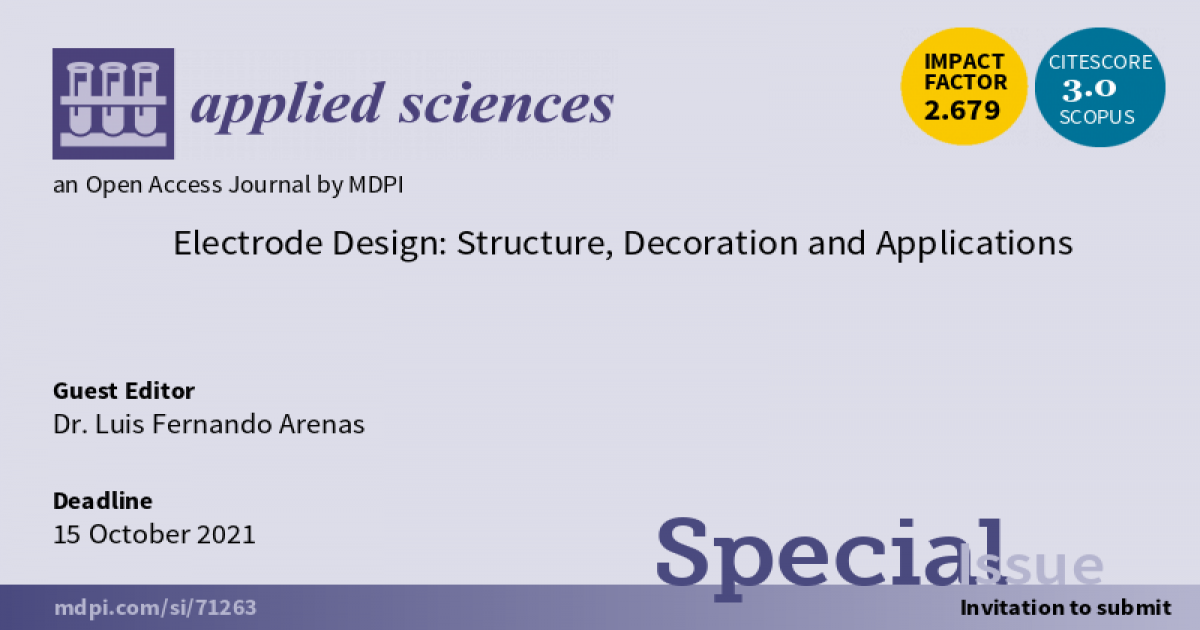Electrode Design: Structure, Decoration and Applications
A special issue of Applied Sciences (ISSN 2076-3417). This special issue belongs to the section "Chemical and Molecular Sciences".
Deadline for manuscript submissions: closed (15 October 2021) | Viewed by 588

Special Issue Editor
2. Faculty of Engineering and Physical Sciences, University of Southampton, Southampton SO17 1BJ, UK
Interests: 3D printing; electrochemical engineering; electrodeposition; energy storage; PEM fuel cells and hydrogen pumps; porous electrodes; flow batteries
Special Issue Information
Dear Colleagues,
Electrode design involves the rational control of the structural architecture and electrocatalytic activity of materials towards the enhancement of productivity, efficiency and durability of electrochemical technologies. Important applications for electrode reactions can be found in electrosynthesis, sensors, water treatment, water electrolysis, environmental remediation as well as in energy storage and conversion. Most of them rely on electrochemical flow reactors, although static cells and stirred tanks are also employed. Continued progress has taken electrode materials from 2D sheets and plates towards 3D textured and porous electrodes which have higher surface area, affording operation at higher currents, lower current densities and enhanced mass transfer. Nowadays, digital design and alternative manufacturing techniques have permitted the creation of electrode structures impossible to produce with traditional approaches.
An explosion of activity has delivered a diversity of advanced novel electrodes. We believe that the rapidly changing state of the art justify a reassessment of this research field. This Special Issue “Electrode Design: Structure, Decoration and Applications” aims to showcase recent developments, disruptive new concepts, validated simulations and creative applications of electrodes for electrochemical technologies. Submissions are expected to focus on the design, production, characterization and use of porous electrodes, although contributions on modified planar electrodes are also welcome.
Topics of interest include, but are not limited to, the following areas:
- Novel electrode architectures for sustainable electrochemical applications and electrochemical energy conversion and storage.
- Porous electrodes based on cellular, periodic or open-foam structures.
- 3D-printing of digitally tailored electrode architectures and materials.
- Advanced imaging and metrology of porous electrodes (e.g. X-ray computed tomography).
- Electrodes decorated with novel electrocatalysts (e.g. nanoparticles).
- Hierarchical micro- and nanostructures at electrode surfaces.
- Metal- and oxide-based electrocatalysts, including composites and alloy coatings.
- Application of electrocatalysts using thermal and hydrothermal methods as well as anodization, galvanic replacement, plasma discharge and vapor deposition techniques.
- Porous electrodes based on perforated plates, foams, meshes, cloths, felts and ‘paper’. Templated porous scaffolds.
- Analytical and numerical models of current and potential distribution and hydrodynamics at such electrodes.
We hope this Special Issue will bring together diverse ideas in the field of electrode design and decoration, demonstrating exiting new applications and pointing out future directions in research and development.
Dr. Luis Fernando Arenas
Guest Editor
Manuscript Submission Information
Manuscripts should be submitted online at www.mdpi.com by registering and logging in to this website. Once you are registered, click here to go to the submission form. Manuscripts can be submitted until the deadline. All submissions that pass pre-check are peer-reviewed. Accepted papers will be published continuously in the journal (as soon as accepted) and will be listed together on the special issue website. Research articles, review articles as well as short communications are invited. For planned papers, a title and short abstract (about 100 words) can be sent to the Editorial Office for announcement on this website.
Submitted manuscripts should not have been published previously, nor be under consideration for publication elsewhere (except conference proceedings papers). All manuscripts are thoroughly refereed through a single-blind peer-review process. A guide for authors and other relevant information for submission of manuscripts is available on the Instructions for Authors page. Applied Sciences is an international peer-reviewed open access semimonthly journal published by MDPI.
Please visit the Instructions for Authors page before submitting a manuscript. The Article Processing Charge (APC) for publication in this open access journal is 2400 CHF (Swiss Francs). Submitted papers should be well formatted and use good English. Authors may use MDPI's English editing service prior to publication or during author revisions.
Benefits of Publishing in a Special Issue
- Ease of navigation: Grouping papers by topic helps scholars navigate broad scope journals more efficiently.
- Greater discoverability: Special Issues support the reach and impact of scientific research. Articles in Special Issues are more discoverable and cited more frequently.
- Expansion of research network: Special Issues facilitate connections among authors, fostering scientific collaborations.
- External promotion: Articles in Special Issues are often promoted through the journal's social media, increasing their visibility.
- Reprint: MDPI Books provides the opportunity to republish successful Special Issues in book format, both online and in print.
Further information on MDPI's Special Issue policies can be found here.





